-
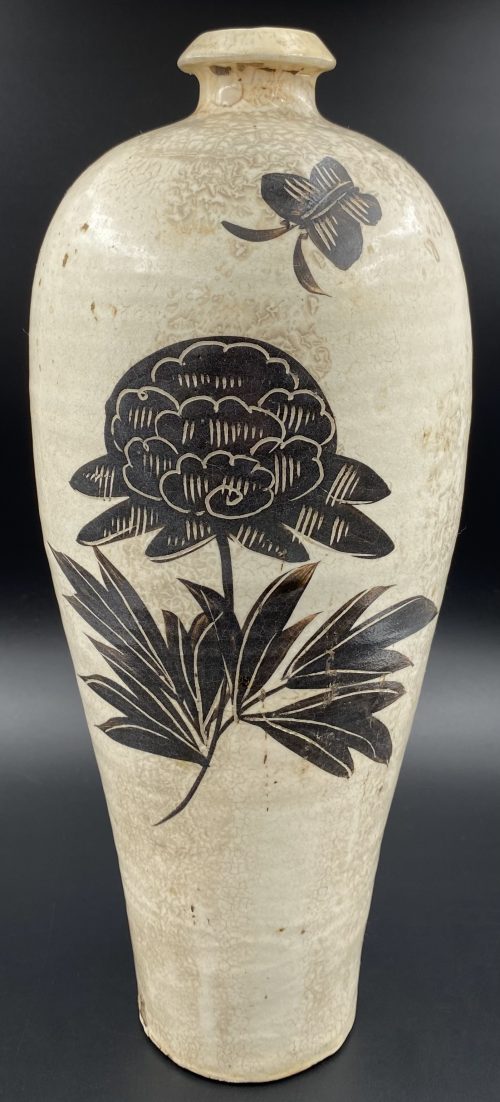 Typical meiping body, short neck, lipped rim; painted in the blackish-brown slip with two blossoms and butterflies under a clear glaze. The foot ring is unglazed exposing the brown body. China, the Yuan Dynasty [大元] (1279 – 1368). Diameter: 14 cm; Height: 30.5 cm.
Typical meiping body, short neck, lipped rim; painted in the blackish-brown slip with two blossoms and butterflies under a clear glaze. The foot ring is unglazed exposing the brown body. China, the Yuan Dynasty [大元] (1279 – 1368). Diameter: 14 cm; Height: 30.5 cm. -
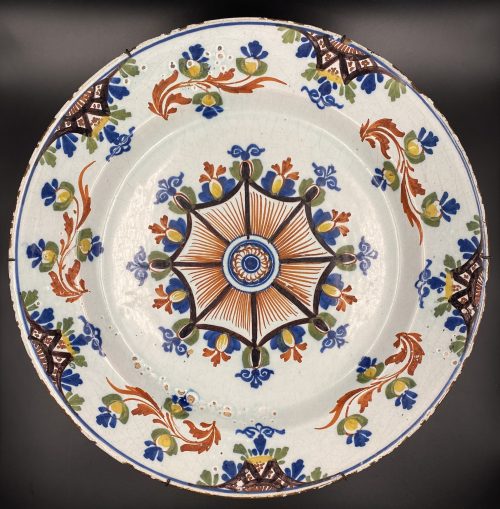 Round plate with an underglaze polychrome design of a blue border and stylized flowers on the rim and octagonal ornament at the centre. Diameter: 34 cm, Haight: 4 cm.
Round plate with an underglaze polychrome design of a blue border and stylized flowers on the rim and octagonal ornament at the centre. Diameter: 34 cm, Haight: 4 cm. -
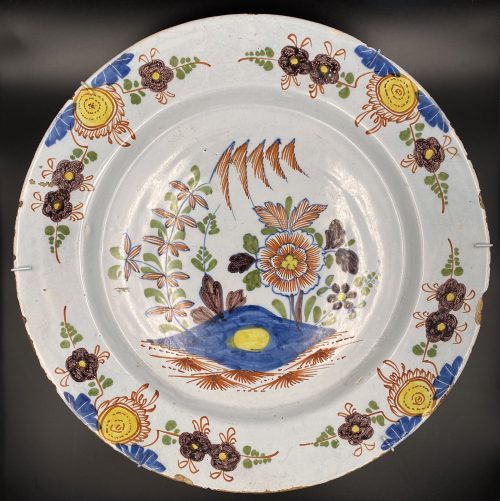 Round plate with a polichrome design of repeating stylized flowers on the rim and a pond reflecting the sun surounded by flowers at the centre. Diameter: 34 cm, Haight: 4 cm.
Round plate with a polichrome design of repeating stylized flowers on the rim and a pond reflecting the sun surounded by flowers at the centre. Diameter: 34 cm, Haight: 4 cm. -
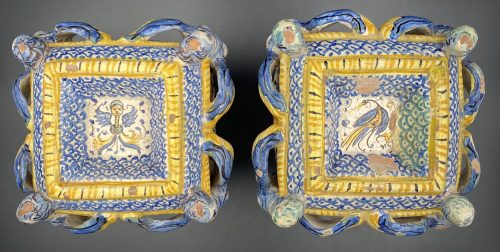 Tin-glazed earthenware salt cellars decorated with winged creatures and grotesque paintings. Restored, losses. Size: 16 x 16 cm; Height: 2.5 cm. Attributed to Deruta, Italy, c. 1600.
Tin-glazed earthenware salt cellars decorated with winged creatures and grotesque paintings. Restored, losses. Size: 16 x 16 cm; Height: 2.5 cm. Attributed to Deruta, Italy, c. 1600. -
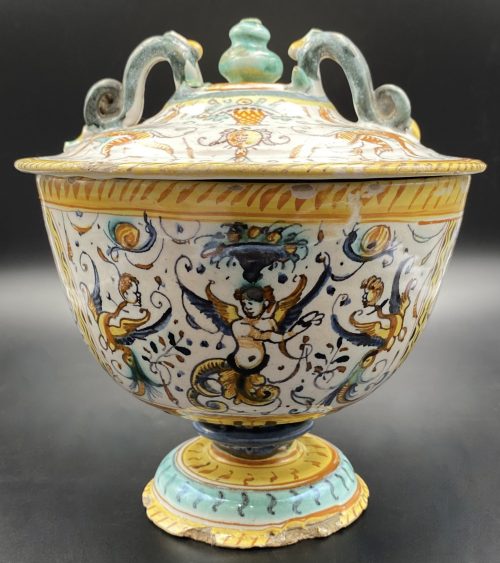 Tin-glazed earthenware footed lidded cup decorated with winged creatures and grotesque paintings, Bachus and Cupid inside. Minor losses Diameter: 16 cm; Height: 18 cm. Attributed to Deruta, Italy, c. 1600.
Tin-glazed earthenware footed lidded cup decorated with winged creatures and grotesque paintings, Bachus and Cupid inside. Minor losses Diameter: 16 cm; Height: 18 cm. Attributed to Deruta, Italy, c. 1600. -
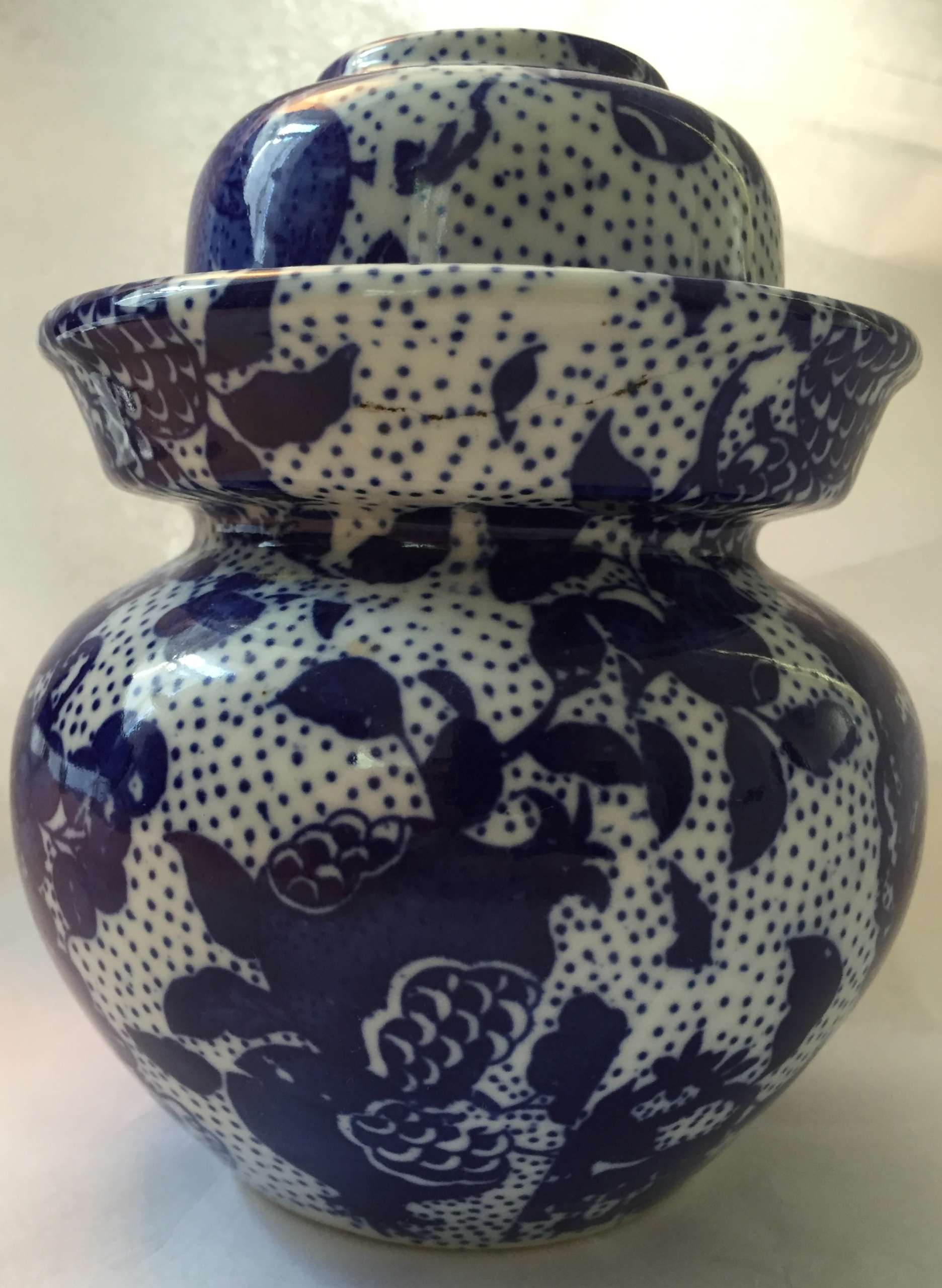 SOLD A Chinese vessel with pomegranates and grapes, of two parts - the vessel and a cup. Blue and white porcelain, decorated under the glaze with a blue pigment by transfer-printing. Imperial reign mark on the bottom in zhuanshu script: Qianlong (1736-1795).
SOLD A Chinese vessel with pomegranates and grapes, of two parts - the vessel and a cup. Blue and white porcelain, decorated under the glaze with a blue pigment by transfer-printing. Imperial reign mark on the bottom in zhuanshu script: Qianlong (1736-1795). -
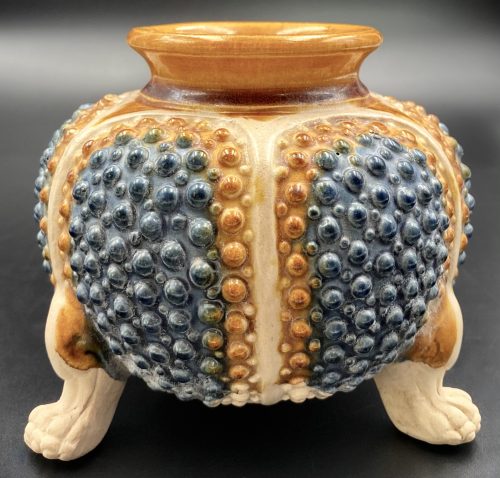 Small six-lobed sancai (blue, amber, and cream) earthenware tripod censer with amber lead glaze mouth, an outer surface of the body decorated in a form of toad skin, the centre of the bottom unglazed, standing on unglazed beast's paws. China, the Tang dynasty [唐朝] (618 – 907). Diameter: 10.2 cm; Height: 9.2 cm.
Small six-lobed sancai (blue, amber, and cream) earthenware tripod censer with amber lead glaze mouth, an outer surface of the body decorated in a form of toad skin, the centre of the bottom unglazed, standing on unglazed beast's paws. China, the Tang dynasty [唐朝] (618 – 907). Diameter: 10.2 cm; Height: 9.2 cm. -
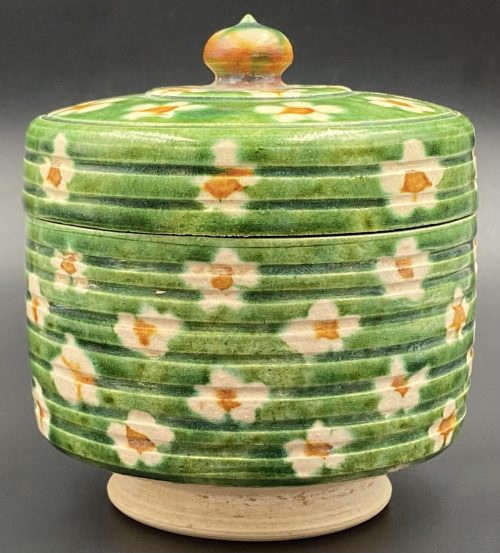 Green, mottled (white, yellow, brown) glazed earthenware jar or a circular box with a cover, on an unglazed foot decorated with florets. The cover has a small knop. Ivory glaze inside. China, the Tang dynasty [唐朝] (618 – 907). Diameter: 10 cm; Height: 10 cm.
Green, mottled (white, yellow, brown) glazed earthenware jar or a circular box with a cover, on an unglazed foot decorated with florets. The cover has a small knop. Ivory glaze inside. China, the Tang dynasty [唐朝] (618 – 907). Diameter: 10 cm; Height: 10 cm. -
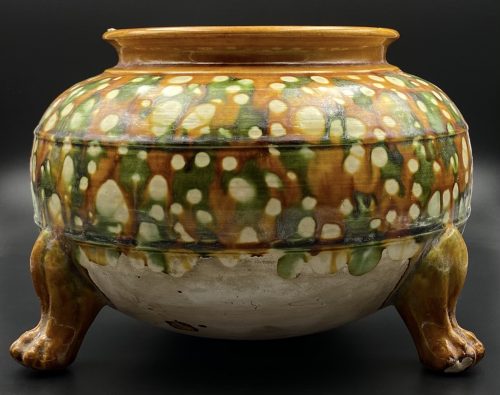 A tripod earthenware jar with the upper half decorated with three-colour glaze in brown, green, and white, and the bottom half unglazed; spur marks to the mouth. Henan kiln. China, the Tang dynasty [唐朝] (618 – 907). Diameter: 22 cm; Height: 15.5 cm
A tripod earthenware jar with the upper half decorated with three-colour glaze in brown, green, and white, and the bottom half unglazed; spur marks to the mouth. Henan kiln. China, the Tang dynasty [唐朝] (618 – 907). Diameter: 22 cm; Height: 15.5 cm -
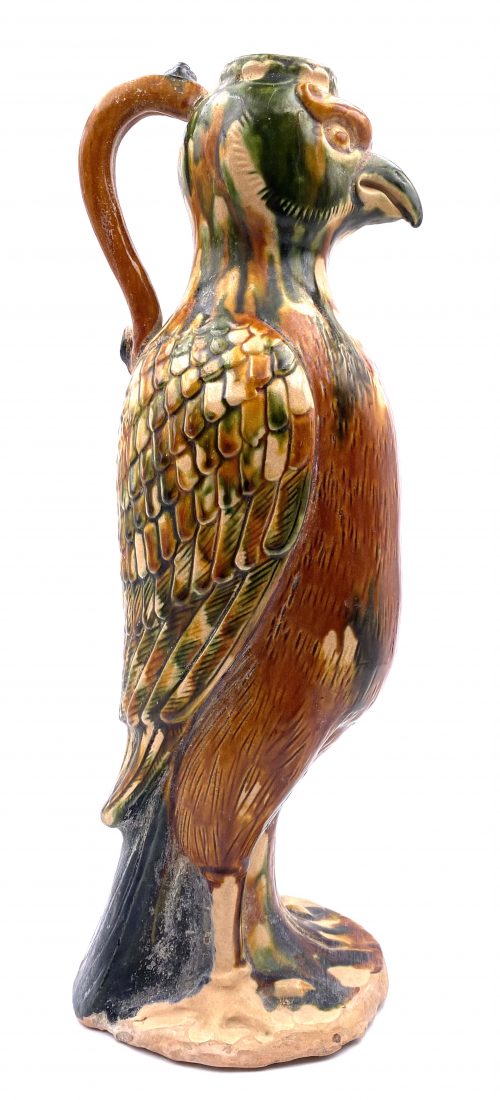 Made of two moulded symmetrical halves, joined before attaching the handle. On an unglazed base. Glazed in three colours (green, amber and ivory) and the tail is glazed black or dark blue. China, the Tang dynasty [唐朝] (618 – 907). Height: 37 cm.
Made of two moulded symmetrical halves, joined before attaching the handle. On an unglazed base. Glazed in three colours (green, amber and ivory) and the tail is glazed black or dark blue. China, the Tang dynasty [唐朝] (618 – 907). Height: 37 cm. -

Sentoku tsuba of oval form with Sennin (Chinese immortal) motif carved in low relief (katakiribori). The Sennin is depicted with a double gourd in his right hand and a child beside his left hip. A pine tree carved on the reverse.
Signed: Sōmin saku (宗眠作) [M.Sesko]. Yokoya School (see The Japanese toso-kinko Schools by Markus Sesko, pp. 133-8).
Edo period (second half of the 18th century). Dimensions: Height: 61.6 mm; Width: 56.4 mm; Thickness: 4.2 mm; Weight: 85 g. -
 Kozuka with seven insects (fly, grasshopper, bee, butterfly, dragonfly, firefly, and cricket) and grass with dewdrops motif. Shakudō, flush gold inlay (hira-zōgan). 95.2 (H) x 13.7 mm (W). Mid Edo period (Late 17th - early 18th century, Genroku era 1688-1703). Unsigned. Kaga school. A look-a-like kozuka (with five insects) is illustrated at Japanese Sword Fittings. A descriptive catalogue of the Collection of G.H. Naunton, Esq., completed and illustrated by Henri L. Joly, - 1912 on plate XXIX, №691 [LIB-1389 in this Collection] with the following description at page 54: "Shakudō, inlaid with butterfly, dragon-fly, grasshopper, locust and another insect, gold."
Kozuka with seven insects (fly, grasshopper, bee, butterfly, dragonfly, firefly, and cricket) and grass with dewdrops motif. Shakudō, flush gold inlay (hira-zōgan). 95.2 (H) x 13.7 mm (W). Mid Edo period (Late 17th - early 18th century, Genroku era 1688-1703). Unsigned. Kaga school. A look-a-like kozuka (with five insects) is illustrated at Japanese Sword Fittings. A descriptive catalogue of the Collection of G.H. Naunton, Esq., completed and illustrated by Henri L. Joly, - 1912 on plate XXIX, №691 [LIB-1389 in this Collection] with the following description at page 54: "Shakudō, inlaid with butterfly, dragon-fly, grasshopper, locust and another insect, gold." See also tsuba TSU-0211 in this collection:
See also tsuba TSU-0211 in this collection:


-
 Shakudō tsuba of the slightly vertically elongated round form (nagamaru-gata) decorated by gold in flat inlay (hira-zōgan) with three insects (cricket, locust, and praying mantis), grass and dewdrops motif. Kogai hitsu-ana is plugged with gilded soft metal. Height: 70.2 mm; width: 66.4 mm x Thickness at seppa-dai: 4.5 mm. Edo period (from ca. 1700 to ca. 1850) Unsigned. Attributed to Kaga School or Murakami School. Almost identical tsuba (no dewdrops, though) is illustrated and described at page 60 of Kokusai Tosogu Kai. 7th International Convention & Exhibition, November 1st, 2011 at Tokyo National Museum, page 60. It is attributed to the Kaga School, Mid Edo period (Late 17th - early 18th century). Dimensions: 70.5 x 66 x 4.5 mm. "The rich black shakudo plate has been slightly lowered (dished out) and then polished. Gold insects crawl amongst grasses, depicted by Kaga style hirazogan (flat inlay). One tendril of the mantis overlaps onto seppa-dai. The mantis boldly looks out from the tsuba in a curious way. This style of Kaga tsuba was popular during the Genroku era (1688-1703)."Another source is Japanese Sword Fittings. A descriptive catalogue of the Collection of G.H. Naunton, Esq., completed and illustrated by Henri L. Joly, - 1912:
Shakudō tsuba of the slightly vertically elongated round form (nagamaru-gata) decorated by gold in flat inlay (hira-zōgan) with three insects (cricket, locust, and praying mantis), grass and dewdrops motif. Kogai hitsu-ana is plugged with gilded soft metal. Height: 70.2 mm; width: 66.4 mm x Thickness at seppa-dai: 4.5 mm. Edo period (from ca. 1700 to ca. 1850) Unsigned. Attributed to Kaga School or Murakami School. Almost identical tsuba (no dewdrops, though) is illustrated and described at page 60 of Kokusai Tosogu Kai. 7th International Convention & Exhibition, November 1st, 2011 at Tokyo National Museum, page 60. It is attributed to the Kaga School, Mid Edo period (Late 17th - early 18th century). Dimensions: 70.5 x 66 x 4.5 mm. "The rich black shakudo plate has been slightly lowered (dished out) and then polished. Gold insects crawl amongst grasses, depicted by Kaga style hirazogan (flat inlay). One tendril of the mantis overlaps onto seppa-dai. The mantis boldly looks out from the tsuba in a curious way. This style of Kaga tsuba was popular during the Genroku era (1688-1703)."Another source is Japanese Sword Fittings. A descriptive catalogue of the Collection of G.H. Naunton, Esq., completed and illustrated by Henri L. Joly, - 1912:
7-U17. Ron Hartmann Collection.
Kanazawa in Kaga was a centre of fine metal work during the whole of the Tokugawa period. At first the inlayers of Fushimi following the Daimyo Maeda went to Kanazawa, then some of the Gotō masters proceeded from Kyoto for short periods to work for the Daimyo, so that their influence was strongly impressed upon Kaga work..." A somewhat look-a-like tsuba is illustrated at plate XXVIII, Kaga Inlay, №653 with the following description at page 52: "Shakudō, inlaid with five insects in gold: crickets, praying mantis, grasshopper, in the style of Takagawara Ujitsugu.
According to M. Sesko, Ujitsugu was a master from Katsuki and Kaneko School in Kaga, son of Ujihira. Ujihira's father Ujiyoshi died in 1802. This brings us to the mid-19th century, instead of mid-18th or earlier. On the other hand, a very much look alike specimen at MFA collection (ACCESSION NUMBER 17.1061) has the with the following description: Edo period. Late 18th–early 19th century. Murakami School. Main material: shakudo; other metals: gold; decorative technique: iroe hirazogan.A detailed account of Murakami school can be found at The Japanese toso-kinko Schools.// Lulu Inc., 2012 by Markus Sesko, on pages 235-239. All-in-all, it's either Kaga School or Murakami School, either ca. 1700 or ca. 1850. Quite a range! SOLD
MFA # 17.1061
-
 Late 19th-century (1850-1870) Japanese export fan. This fan has a double leaf painted with a different design on either side. Ivory encrusted with gemstones and other materials. Subject matter such as women wearing kimono is also more typical of export than domestic products (V&A). Autumn theme on the reverse.
Late 19th-century (1850-1870) Japanese export fan. This fan has a double leaf painted with a different design on either side. Ivory encrusted with gemstones and other materials. Subject matter such as women wearing kimono is also more typical of export than domestic products (V&A). Autumn theme on the reverse. -
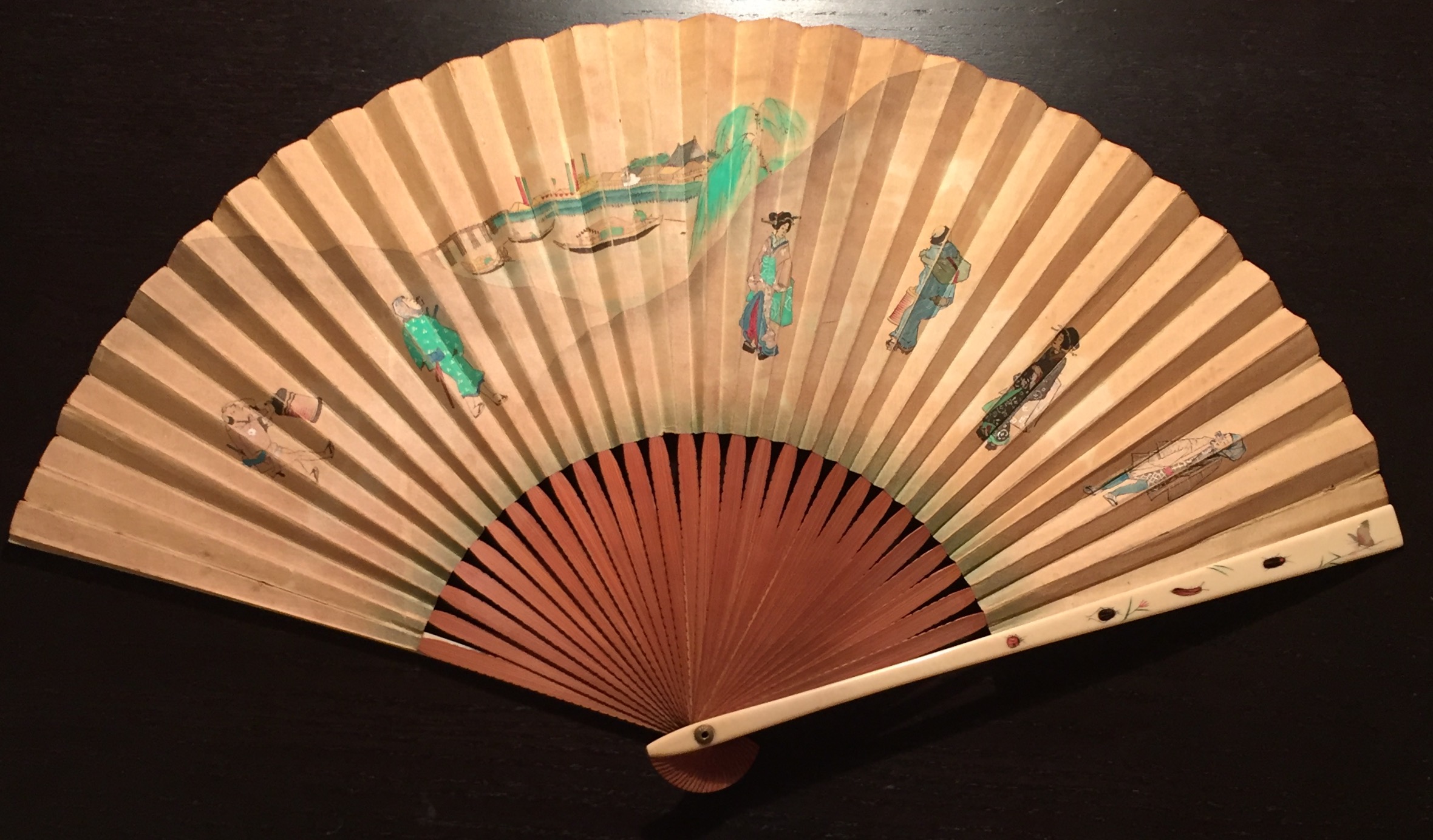 Late 19th-century (1850-1870) Japanese export fan. This fan has a double leaf painted with a different design on either side. Ivory encrusted with gemstones and other materials. Subject matter such as women wearing kimono is also more typical of export than domestic products (V&A). Summer (birds and flowers) theme on the reverse.
Late 19th-century (1850-1870) Japanese export fan. This fan has a double leaf painted with a different design on either side. Ivory encrusted with gemstones and other materials. Subject matter such as women wearing kimono is also more typical of export than domestic products (V&A). Summer (birds and flowers) theme on the reverse. -
 Late 19th-century (1850-1870) Japanese export fan. This fan has a double leaf painted with a different design on either side. Ivory encrusted with gemstones (birds and shippomon motif). Painting by ukiyo-e artist and printmaker Katsushika Isai (1821–1880) represents a riverside landscape with figures; birds and flowers on the reverse. Signed: Isai ga (為斎画) - "Painted by Isai".
Late 19th-century (1850-1870) Japanese export fan. This fan has a double leaf painted with a different design on either side. Ivory encrusted with gemstones (birds and shippomon motif). Painting by ukiyo-e artist and printmaker Katsushika Isai (1821–1880) represents a riverside landscape with figures; birds and flowers on the reverse. Signed: Isai ga (為斎画) - "Painted by Isai". -
 Shibuichi Kozuka carved in low relief (takabori, usuniku-bori) and inlaid in gold and silver with design of Shoko, reading by moonlight, thatch, pine rosettes, and fool moon. According to Henri L. Joly [LEGEND IN JAPANESE ART. London, 1908; LIB-1416 in this collection] Shoko was a Chinese student of Taoism who was so poor that he had no money to buy illuminating materials and read by moonlight. Shoko mentioned in the article about another Chinese character - Shaen, who was reading by the light emitted by glow-worms (see page 310). Signed on the back: Haruchika (春親) + kaō. Size: 97.3 mm (H) x 14.8 mm (W). Edo period, mid 19th century. NBTHK Certificate № 449542. Hamano Haruchika from Edo was a student of Haruyuki in 1848-54; Hamano School, Etchū Toyama Branch, according to M. Sesko's "Genealogy", page. 34. Most probably it is his work. Following the MFA data, it is also possible that "our" Haruchika is indeed Nara Haruchika or Tsuchiya Haruchika from Nara School; though I did not hind such artist in Markus Sesko books. However, in his "Toso-Kinko" on page 177 there is certain Shingorō who carried out his business under the name of Yanagawa Haruchika (1791-1857?)
Shibuichi Kozuka carved in low relief (takabori, usuniku-bori) and inlaid in gold and silver with design of Shoko, reading by moonlight, thatch, pine rosettes, and fool moon. According to Henri L. Joly [LEGEND IN JAPANESE ART. London, 1908; LIB-1416 in this collection] Shoko was a Chinese student of Taoism who was so poor that he had no money to buy illuminating materials and read by moonlight. Shoko mentioned in the article about another Chinese character - Shaen, who was reading by the light emitted by glow-worms (see page 310). Signed on the back: Haruchika (春親) + kaō. Size: 97.3 mm (H) x 14.8 mm (W). Edo period, mid 19th century. NBTHK Certificate № 449542. Hamano Haruchika from Edo was a student of Haruyuki in 1848-54; Hamano School, Etchū Toyama Branch, according to M. Sesko's "Genealogy", page. 34. Most probably it is his work. Following the MFA data, it is also possible that "our" Haruchika is indeed Nara Haruchika or Tsuchiya Haruchika from Nara School; though I did not hind such artist in Markus Sesko books. However, in his "Toso-Kinko" on page 177 there is certain Shingorō who carried out his business under the name of Yanagawa Haruchika (1791-1857?) -
 Shimizu-Jingo tsuba with a dragon and vajra (on reverse) motif. Unsigned. Possibly, 3rd or 4th master of Shimizu-Jingo family in Higo province. Iron. Low relief carving. Edo period, 1700's. Height: 75.4 mm, Width: 72.2 mm, Thickness at seppa-dai: 4.0 mm
Shimizu-Jingo tsuba with a dragon and vajra (on reverse) motif. Unsigned. Possibly, 3rd or 4th master of Shimizu-Jingo family in Higo province. Iron. Low relief carving. Edo period, 1700's. Height: 75.4 mm, Width: 72.2 mm, Thickness at seppa-dai: 4.0 mm


